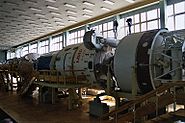Coordinates: 55°52′28″N 38°06′54″E / 55.8745°N 38.115°E

The grounds of the Gagarin Cosmonauts Training Center
The Yuri A. Gagarin State Scientific Research-and-Testing Cosmonaut Training Center (GCTC)[1] is a Russian training facility responsible for training cosmonauts for their space missions. It is the first cosmonaut training facility in Russia.[citation needed] It is located in Star City, Russia—a name which may refer to the facility itself and to the grounds on which it is located.
Formation[]
The facility was originally known only as Military Unit 26266 or в/ч 26266, and was a secret training base for Soviet Cosmonaut candidates. The site was chosen for its proximity to Moscow and other infrastructure that would be essential for its function: Chkalovsky Airbase, and the Yaroslavl railroad.[2] The densely forested area was originally a radar range with some existing infrastructure.[citation needed]
Military physician Colonel Yevgeny Karpov was appointed as the first chief of the cosmonaut training centre or Tsentr Podgotovki Kosmonavtov (TsPK) on February 24, 1960.[3] The centre was home to approximately 250 personnel divided into various departments who were responsible for the development of all aspects of the space program ranging from equipment to the well being of the cosmonauts. These included specialists in heat exchange and hygiene, survival clothing, surgery, and training staff. Initially cosmonaut candidates were housed at the nearby Frunze Central Airfield (Moscow), followed by an apartment block in Chkalovsky[2] before eventually moving to the newly built apartments on site where they would remain with their families throughout training.
Civilian administration[]
Until April 2009 the center was owned and operated by the Russian Ministry of Defense in cooperation with Russian Federal Space Agency. On April 2009, Russia President Dmitry Medvedev signed a presidential decree transferring the center from the Defence Ministry to the Russian Federal Space Agency (Roskosmos)[4] The current[when?] administrator of the GCTC is cosmonaut Sergei Krikalyov.[citation needed]
The Cosmonaut Training Center was inaugurated on January 11, 1960 in Star City outside Moscow.[citation needed] In 1969 it was named after Yuri Gagarin, the first man to fly in space. In 1995 the Cosmonaut Training Center and Air Force Test and Training regiment were merged and reorganized into its current form.[Clarification needed]
The Center has also trained candidates from other countries of (or aligned to) the former Soviet bloc under the Intercosmos program, which got an initial boost from the joint Soviet-American Apollo-Soyuz flight in 1975. The Intercosmos program later included staff members from other countries as well (France, India, etc.) and provided ground work for the next step in continued and ongoing cooperation between Russia and the United States in joint space missions and for cross-training of US astronauts on Russian hardware in the framework of the Space Shuttle-Mir and ISS programs.[citation needed]
Key infrastructure[]
The facility contains infrastructure essential for the training of cosmonauts across a wide range of experiences, including simulating g-loads, mission specific/suit training, medical observation/testing and astronavigation.
Key GCTC facilities include:
- Full-size mockups of all major spacecraft developed since the Soviet era, including the Soyuz and Buran vehicles, the TKS modules and orbital stations of the Salyut Program, Mir, and ISS. These were coexisting or with time replaced one another inside two main training hangar halls of the Center. Room 1 houses the Salyut 4, 6, Mir (Don-17KS) with Kvant (Don-37KE), Kvant 2 (Don-77KSD) and Kristall (Don-77KST) modules and a Soyuz 2 descent module simulators. Room 1A houses the Soyuz simulators (Don-7ST3 -old STK-7ST - for the Soyuz TMA; TDK-7ST4 - old TDK-7TS2 for Soyouz TM - for the Soyuz TMM; Don-732M modified for Soyuz TM and the Pilot 732 - for the TORU docking system).Other rooms house the Salyut 7, Spectr (Don-77KSO), Priroda (Don-77KSI), Buran, Zarya and Zvezda simulators.
- Zero-gravity training aircraft for simulating weightlessness (cf. Vomit Comet), including the MiG-15 UTI, Tupolev Tu-104 and later the IL-76 MDK with internal volume of 400 cubic metres (14,000 cu ft). Training aircraft are based at the Russian Air Force base at Chkalovskiy airfield.[citation needed]
- A Medical observation clinic and testing facility.
- A planetarium built in East Germany, capable of projecting as many as 9,000 stars.[citation needed]
- The original office of Yuri Gagarin and a number of monuments and busts to him and other cosmonauts.
Notes[]
- ↑ Russian: Российский Государственный Научно-Исследовательский Испытательный Центр Подготовки Космонавтов (РГНИИЦПК) им. Ю. А. Гагарина, Rossiyskiy Gosudarstvenny Nauchno-Issledovatelsky Ispytatelny Tsentr Podgotovki Kosmonavtov (RGNIITsPK) im. Yu. A. Gagarina
- ↑ 2.0 2.1 Burgess and Hall, p.30
- ↑ Burgess and Hall, p.29
- ↑ Itar Tass, Medvedev demands hand over Cosmonauts Training Center to Roskosmos, 10.4.09
References[]
- Colin Burgess, Rex Hall (June 2, 2010). The first Soviet cosmonaut team: their lives, legacy, and historical impact. Praxis. pp. 356. ISBN 0-387-84823-1.
External links[]
| Wikimedia Commons has media related to Yuri Gagarin Cosmonauts Training Center. |
The original article can be found at Yuri Gagarin Cosmonaut Training Center and the edit history here.





